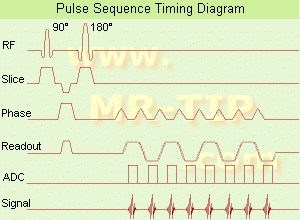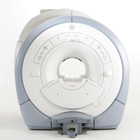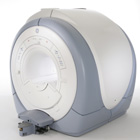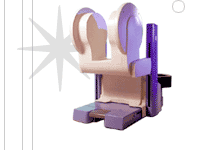 | Info
Sheets |
| | | | | | | | | | | | | | | | | | | | | | | | |
 | Out-
side |
| | | | |
|
| | | 'Magnetic Resonance Imaging MRI' | |
Result : Searchterm 'Magnetic Resonance Imaging MRI' found in 1 term [ ] and 9 definitions [ ] and 9 definitions [ ], (+ 18 Boolean[ ], (+ 18 Boolean[ ] results ] results
| previous 16 - 20 (of 28) nextResult Pages :  [1] [1]  [2] [2]  [3 4 5 6] [3 4 5 6] |  | |  | Searchterm 'Magnetic Resonance Imaging MRI' was also found in the following services: | | | | |
|  |  |
| |
|

(EPI) Echo planar imaging is one of the early magnetic resonance imaging sequences (also known as Intascan), used in applications like diffusion, perfusion, and functional magnetic resonance imaging. Other sequences acquire one k-space line at each phase encoding step. When the echo planar imaging acquisition strategy is used, the complete image is formed from a single data sample (all k-space lines are measured in one repetition time) of a gradient echo or spin echo sequence (see single shot technique) with an acquisition time of about 20 to 100 ms.
The pulse sequence timing diagram illustrates an echo planar imaging sequence from spin echo type with eight echo train pulses. (See also Pulse Sequence Timing Diagram, for a description of the components.)
In case of a gradient echo based EPI sequence the initial part is very similar to a standard gradient echo sequence. By periodically fast reversing the readout or frequency encoding gradient, a train of echoes is generated.
EPI requires higher performance from the MRI scanner like much larger gradient amplitudes. The scan time is dependent on the spatial resolution required, the strength of the applied gradient fields and the time the machine needs to ramp the gradients.
In EPI, there is water fat shift in the phase encoding direction due to phase accumulations. To minimize water fat shift (WFS) in the phase direction fat suppression and a wide bandwidth (BW) are selected. On a typical EPI sequence, there is virtually no time at all for the flat top of the gradient waveform. The problem is solved by "ramp sampling" through most of the rise and fall time to improve image resolution.
The benefits of the fast imaging time are not without cost. EPI is relatively demanding on the scanner hardware, in particular on gradient strengths, gradient switching times, and receiver bandwidth. In addition, EPI is extremely sensitive to image artifacts and distortions. | |  | | | | | | | | |  Further Reading: Further Reading: | Basics:
|
|
| |
|  |  | Searchterm 'Magnetic Resonance Imaging MRI' was also found in the following services: | | | | |
|  |  |
| |
|

From GE Healthcare;
The GE Signa HDx MRI system is a whole body magnetic resonance scanner designed to support high resolution, high signal to noise ratio, and short scan times.
The 1.5T Signa HDx MR Systems is a modification of the currently marketed GE 1.5T machines, with the main difference being the change to the receive chain architecture that includes a thirty two independent receive channels, and allows for future expansion in 16 channel increments. The overall system has been improved with a simplified user interface
and a single 23" liquid crystal display, improved multi channel surface coil connectivity, and an improved image reconstruction architecture known as the Volume Recon Engine (VRE).
Device Information and Specification CLINICAL APPLICATION Whole body CONFIGURATION Compact short bore Standard: SE, IR, 2D/3D GRE and SPGR, Angiography: 2D/3D TOF, 2D/3D Phase Contrast; 2D/3D FSE, 2D/3D FGRE and FSPGR, SSFP, FLAIR, EPI, optional: 2D/3D Fiesta, FGRET, Spiral, Tensor, 2D 0.7 mm to 20 mm; 3D 0.1 mm to 5 mm 128x512 steps 32 phase encode POWER REQUIREMENTS 480 or 380/415 less than 0.03 L/hr liquid helium | |  | | | |
|  | |  |  |  |
| |
|

From GE Healthcare;
The Signa HDx MRI system is GE's leading edge whole body magnetic resonance scanner designed to support high resolution, high signal to noise ratio, and short scan times.
Signa HDx 3.0T offers new technologies like ultra-fast image reconstruction through the new XVRE recon engine, advancements in parallel imaging algorithms and the broadest range of premium applications. The HD applications, PROPELLER (high-quality brain imaging extremely resistant to motion artifacts), TRICKS (contrast-enhanced angiographic vascular lower leg imaging), VIBRANT (for breast MRI), LAVA (high resolution liver imaging with shorter breath holds and better organ coverage) and MR Echo (high-definition cardiac images in real time) offer unique capabilities.
Device Information and Specification CLINICAL APPLICATION Whole body
CONFIGURATION Compact short bore SE, IR, 2D/3D GRE, RF-spoiled GRE, 2DFGRE, 2DFSPGR, 3DFGRE, 3DFSPGR, 3DTOFGRE, 3DFSPGR, 2DFSE, 2DFSE-XL, 2DFSE-IR, T1-FLAIR, SSFSE, EPI, DW-EPI, BRAVO, Angiography: 2D/3D TOF, 2D/3D phase contrast vascular IMAGING MODES Single, multislice, volume study, fast scan, multi slab, cine, localizer H*W*D 240 x 2216,6 x 201,6 cm POWER REQUIREMENTS 480 or 380/415, 3 phase ||
COOLING SYSTEM TYPE Closed-loop water-cooled grad. | |  | | | |
|  |  | Searchterm 'Magnetic Resonance Imaging MRI' was also found in the following services: | | | | |
|  |  |
| |
|

From Odin Medical Technologies, Inc.;
the PoleStar™ N-10 is a compact, mobile MRI scanner that mounts to a standard operating room table. The magnets raise into position for imaging, but lower to make surgery easier, and the low magnetic field makes it possible to use many conventional surgical instruments.
When not in use, the PoleStar™ is stored in a nearby closet that allows the room to be used for conventional surgical procedures. The PoleStar™ N-10 is supplied with a fully integrated image guidance system that utilizes intraoperatively acquired images.
The successor, the new PoleStar™ N20 sets a new standard in intraoperative magnetic resonance imaging.
Device Information and Specification CLINICAL APPLICATION Intraoperative | |  | |
• View the DATABASE results for 'PoleStar™' (2).
| | | | |
|  |  | Searchterm 'Magnetic Resonance Imaging MRI' was also found in the following services: | | | | |
|  |  |
| |
|

ISOL Technology participated in the pioneering the Korea's MRI development since the early 1980's. In spite of the rapidly changing business environment, and severe competition in the overall medical market, ISOL Technology has grown steadily each year and has established itself as a major provider of Magnetic Resonance(MR) Imaging Systems in Korea.
ISOL Technology also has the largest market share of the domestic bone densitometry equipment sales and is currently in the early stages of development of the 61 channel MCG (Magnetocardiography) system with the R and D funds from the Korean Ministry of Commerce, Industry and Energy.
MRI Scanners:
Contact Information
MAIL
ISOL Technology
203 Neungpyeong-ri
Opo-eub, Gwangju-si, Gyeonggi-do
Zip Code : 464-892
Korea
| |  | |
• View the DATABASE results for 'ISOL Technology' (5).
| | | | |
|  | |  |  |
|  | |
|  | | |
|
| |
 | Look
Ups |
| |